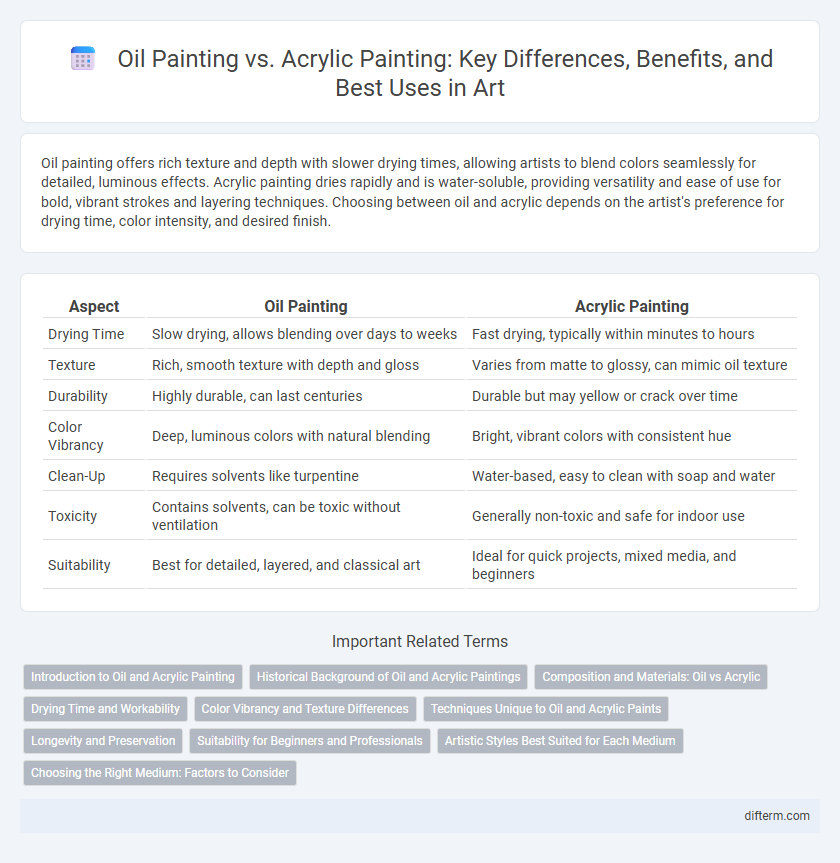Oil painting offers rich texture and depth with slower drying times, allowing artists to blend colors seamlessly for detailed, luminous effects. Acrylic painting dries rapidly and is water-soluble, providing versatility and ease of use for bold, vibrant strokes and layering techniques. Choosing between oil and acrylic depends on the artist's preference for drying time, color intensity, and desired finish.
Table of Comparison
| Aspect | Oil Painting | Acrylic Painting |
|---|---|---|
| Drying Time | Slow drying, allows blending over days to weeks | Fast drying, typically within minutes to hours |
| Texture | Rich, smooth texture with depth and gloss | Varies from matte to glossy, can mimic oil texture |
| Durability | Highly durable, can last centuries | Durable but may yellow or crack over time |
| Color Vibrancy | Deep, luminous colors with natural blending | Bright, vibrant colors with consistent hue |
| Clean-Up | Requires solvents like turpentine | Water-based, easy to clean with soap and water |
| Toxicity | Contains solvents, can be toxic without ventilation | Generally non-toxic and safe for indoor use |
| Suitability | Best for detailed, layered, and classical art | Ideal for quick projects, mixed media, and beginners |
Introduction to Oil and Acrylic Painting
Oil painting offers rich texture and vibrant colors with slow drying times, allowing for detailed blending and layering techniques. Acrylic painting, favored for its quick drying properties and versatility, can mimic the appearance of oils or watercolors, making it ideal for rapid execution and experimental styles. Both mediums provide unique artistic possibilities, with oils suited for depth and richness, while acrylics cater to modern, dynamic approaches.
Historical Background of Oil and Acrylic Paintings
Oil painting, originating in the early 15th century during the Northern Renaissance, revolutionized art with its slow drying time and rich texture, famously used by masters like Jan van Eyck and Rembrandt. Acrylic painting, developed in the mid-20th century, introduced synthetic polymers that dry quickly and offer versatility, gaining popularity with modern artists seeking vibrant, durable finishes. The historical progression from oil to acrylic highlights a shift in artistic techniques and materials shaped by technological advancements and evolving creative needs.
Composition and Materials: Oil vs Acrylic
Oil paintings utilize slow-drying pigments suspended in linseed oil, allowing artists to achieve rich blending, subtle gradients, and complex textures that enhance composition depth. Acrylic paints, made from pigment suspended in an acrylic polymer emulsion, dry quickly and enable layering with crisp edges and vibrant colors, supporting bold, graphic composition styles. The choice between oil and acrylic materials decisively influences techniques, drying times, and the final visual impact within artistic compositions.
Drying Time and Workability
Oil painting offers a slow drying time, often taking days to weeks, which allows artists extended workability for blending and detailed layering. Acrylic painting dries rapidly, usually within minutes to hours, enabling quicker layering but limiting the time available for smooth blending. The choice between oil and acrylic depends on the artist's preference for flexibility in manipulation versus fast project completion.
Color Vibrancy and Texture Differences
Oil painting offers richer color vibrancy due to its slow drying time allowing pigments to blend smoothly, creating deep, luminous hues unmatched by acrylics. Acrylic painting dries quickly, resulting in more matte finishes and brighter, more saturated colors but with less subtle blending capabilities. Texture-wise, oils provide thicker, more buttery layers ideal for impasto techniques, while acrylics can be manipulated with mediums to mimic similar textures but typically remain thinner and less tactile.
Techniques Unique to Oil and Acrylic Paints
Oil painting offers unparalleled blending capabilities due to its slow drying time, allowing artists to create smooth gradients and intricate glazing techniques. Acrylic paints dry rapidly, enabling layering techniques such as impasto and texture building without long waiting periods, making it ideal for dynamic, fast-paced work. The unique chemical properties of oil support traditional methods like alla prima, while acrylic's water-solubility facilitates easy cleanup and experimental mixed-media applications.
Longevity and Preservation
Oil paintings are renowned for their exceptional longevity, with many masterpieces lasting over centuries due to the slow drying process that allows for a durable, stable surface. Acrylic paintings, while more resistant to environmental factors like humidity and UV light, can degrade faster over time if not properly varnished or stored. Preservation of oil paint requires careful control of temperature and humidity to prevent cracking, whereas acrylics benefit from less demanding conservation conditions but may experience color fading or brittleness after prolonged exposure.
Suitability for Beginners and Professionals
Oil painting offers rich texture and slow drying time, making it ideal for professional artists who require blending and layering over extended periods. Acrylic painting dries quickly and is water-soluble, providing beginners with an easy-to-use medium that allows for rapid correction and experimentation. Both mediums require different skill sets: oil demands patience and control, while acrylic suits those seeking versatility and faster results.
Artistic Styles Best Suited for Each Medium
Oil painting excels in creating rich textures and depth, making it ideal for styles like realism and classical portraiture where blending and layering multiple colors are essential. Acrylic painting dries quickly and offers versatility, supporting bold, vibrant abstract art and modern mixed media techniques that benefit from fast layering and sharp edges. Artists often choose oil for its luminous glazing effects and acrylic for its adaptability to various surfaces and experimental approaches.
Choosing the Right Medium: Factors to Consider
Oil painting offers rich texture and vibrant color depth ideal for detailed blending and longer working time, while acrylic painting dries quickly, enabling fast layering and easier cleanup. When choosing the right medium, consider factors such as drying time, color permanence, surface compatibility, and desired finishing effects to match your artistic style and project needs. Environmental safety and ventilation requirements also play a crucial role, as oil paints often require solvents that may emit strong fumes, whereas acrylics are water-based and generally safer for indoor use.
Oil painting vs Acrylic painting Infographic

 difterm.com
difterm.com